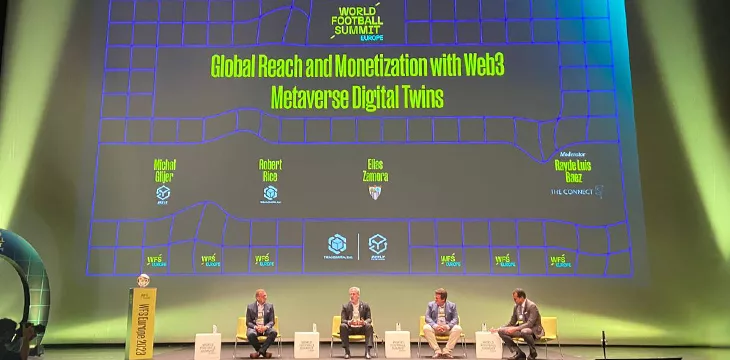|
Getting your Trinity Audio player ready...
|
The World Football Summit is the biggest industry event in football, and it kicked off on September 20 in Sevilla, Spain.
Joining a panel titled “Global Reach and Monetization with Web 3 and Metaverse Digital Twins” were Robert Rice of Transmira, Inc. and Mike Glijer of Zetly. They joined Elias Zamora-Sillero from Savilla FC and Rayde Luis Baez from brand-building firm The Connect.
The potential of digital twins
Baez kicks off the panel by acknowledging that Web3 has a bad reputation thanks to the shenanigans in the digital currency industry over the past few years. However, digital twins have been around for a while now and have great potential to revolutionize entire industries.
Rice says that digital twins link back to something in the real world, unlike purely metaverse-based concepts. They should be 1:1 copies that can tie into local businesses, cultural aspects, etc.
Monetizing digital twins
Baez wants to know how digital twins can be monetized. He rightly says that investment should yield a return.
Sillero states that, over the past decade, content has been at the forefront of the brand’s engagement strategies. All interaction with content must be measured to determine things like ROI. The metaverse and digital twins will play a role in direct monetization, which is more easily measured.
Baez imagines a scenario in which sports games are broadcast in 3D. Since 99% of a team’s fan base will never attend the stadium in person, this gives them a chance to attend virtually, enhancing loyalty to the team by having a great experience.
Rice says that, to date, product placements have been inside banners. However, with digital twins in the metaverse, we can have things like Nike shoes on avatars. These will be linked to real-world shoes with discounts attached. In this way, marketers can directly prove and validate spending. Lots of customization and targeting are possible.
Glijer says fan engagement can be much more fun thanks to these tools. However, clubs need to be educated as to how to build on engagement platforms like his. “The possibilities are endless,” he says.
Football is not Super Mario Bros
Sillero points out that football is not a purely virtual thing—it’s very much rooted in the real world. “Football is not Super Mario Bros,” he says. It has generational support and is often profoundly interwoven with communities. The fans are real people who’ll want the 3D experience to be as real as possible.
Staying on the theme of football’s real-world implications, Baez wants to know how digital twins can help with real-world operational issues, making the fan experience better and streamlining the process from buying a ticket to getting into the stadium.
Picking up on this point, Rice says that digital twins of stadiums can be linked to other systems and data on crowds, crime statistics, traffic, and even climate data. Each feeds into the other, enhancing it, but digital twins of entire cities will ultimately be needed to make it all possible.
Glijer says the metaverse will not just affect game attendees. Others worldwide can interact with real people as avatars, attend virtual museums for their clubs, etc.
Rice notes that none of this is limited to game day. Clubs can engage fans globally all year long. Endless new ways of engaging them are opened up along with new revenue streams, new fans outside the local area, and much more.
Glijer wraps up by highlighting how the behavior of fans is changing. Clubs will struggle to engage a new generation of digital natives. Digital twins and the metaverse can play a role here.
Interested in learning more?
Those interested in learning more about the metaverse and digital twins can check out how Transmira and Zetly harness the BSV blockchain’s power to create the digital twins and next-generation fan engagement platforms discussed on this panel.
A scalable public blockchain will be required for any of this to be possible. Right now, only one fits the description—BSV blockchain.
Watch The Web3 trifecta: Robert Rice talks about combining AI, metaverse, and blockchain into one

 12-25-2025
12-25-2025 




